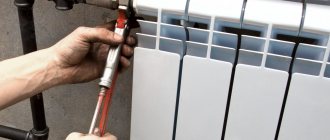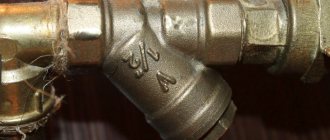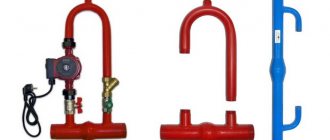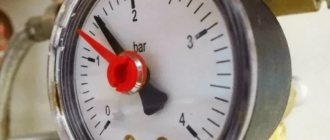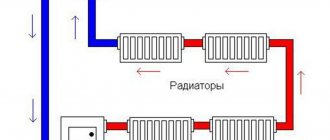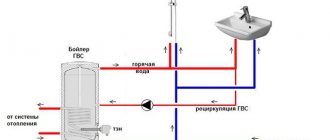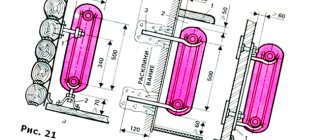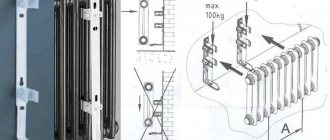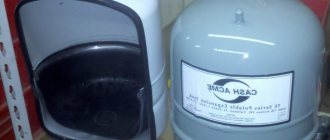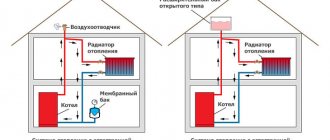There are frequent situations when the problem of a heating battery not heating arises. Sometimes you have to rack your brain in search of the reasons why the situation is happening and how to fix it. We have collected for you 7 possible reasons why radiators may not heat up and offer to study each in detail.
Important! This article is especially relevant when starting heating systems. Many, like you at the moment, may be experiencing difficulties with batteries. Your repost of our material may help someone quickly solve their problem. Don't forget to click on the social buttons. networks at the very bottom of the article!
Bypass
The bypass is the same pipe that stands in front of the installed heating device. Everyone has one, it’s needed to bypass water past the battery. If installed incorrectly - too far from the radiator, or in line with the central riser, it does not allow water, which tends to travel along the shortest path, to circulate normally, heating the radiator sections. In this situation, they will either not heat at all or will be very bad. Check how your bypass is installed. Perhaps this is the direct reason why the batteries do not heat up
Why don't the batteries heat up?
You have noticed that the last battery in the home heating circuit is cold. What to do? Experts advise first determining the nature of the breakdown. It can be both global and local in nature. In the first case, you need to pay attention to the correct installation of the bypass and the heating element itself. The breakdown can be eliminated only by redoing the heating wiring in the house.
Local breakdowns include air pockets and contamination inside the heating element. They are the main reason why the middle or last battery in the heating system is cold. These problems can be fixed by a person without professional skills. But the help of specialists will not hurt here.
Three way valve
Such a tap is required to switch the bypass-battery direction. If this is the reason that the radiator does not heat, then the problem can be eliminated in 3 ways:
- No disassembly. In cases where the tap turns easily, but switching does not occur at all (neither one nor the other works), you can try to develop the device using multiple turning movements. In this case, blockages, as a rule, are washed away by the flow, going into the riser. The operation of shut-off valves is restored in full.
- With partial disassembly. There's no way to turn the tap? We're not trying to break it. Carefully unscrew the locking screw of the handle, remove it, place the screw back in order to prevent deformation of the part during further work. Further actions are carried out with a wrench. It is not recommended to use round nose pliers, pliers, etc. The reason is the same as with the screw - not to damage the rod. Holding the rod with a wrench, we smoothly rock it back and forth, starting with minimal vibrations. If you cannot make minimal movements, slightly loosen the large hex nut that presses the stuffing box seal. If it starts to dig in, place a small container. Continuing the work, moving the rod, press the seal into place, turning the large nut back accordingly. We unscrew the screw, install the handle, screw in the screw, and rejoice.
- In rare cases, when the internal stop is simply torn off, the crane has the ability to “spun in a circle” endlessly - we simply select the position of the handle in which normal operation is ensured.
A few suggestions on how to clean the battery at home
Remember that you perform all actions at your own peril and risk; if you have not had such experience, it is better to call a plumber who is more experienced.
- If you still decide to do everything yourself, then when cleaning batteries you should remember safety first. The coolant is very hot - don't get burned!
- The radiator is cleaned only by supplying high water pressure. Simply “washing” the radiator under the tap and removing all the debris from it this way will not work. It is best if you can connect a special hose hermetically and thoroughly “blow” the sections with water.
- Don't clog your drain with radiator debris. It is better to perform this operation on the street.
- If serious blockages are found in one battery, then most likely all the others are clogged. Repeat the operation for all heating appliances in your home.
Human factor
A person can also become the direct cause of a non-heating radiator. And usually they are as follows:
- A riser that they simply forgot to turn on because “it was late and the plumbers were tired.”
- Closed valve of the automatic air vent system.
- Incorrect connection during installation.
- Child-closed three-way valve.
They can be solved by calling the appropriate support service, correctly connecting the battery (or bypass, see below), and carefully checking the taps.
Adviсe
So, if you find that the radiators in the apartment have become cold or not warm enough, we recommend doing the following:
- Determine the type of possible breakdown. If this is a separate battery, then it is necessary to shut off the flow of coolant into this element. This can be done using a supply valve.
- Wait for the liquid to cool and disconnect the damaged, non-functional battery.
- Clean the system or install a new battery.
- Allow coolant to flow in and check the operation of the entire system.
Today, important parameters when choosing radiators and radiators are heat transfer and efficiency. Thoughtful solutions using the quality characteristics of metal make it possible to obtain not only durable, but also more practical elements for heating an apartment or room.
That's why many people strive to replace old cast iron batteries and install modern and more economical ones. In addition, the aesthetic appearance of the batteries is not the least important. Today there is a choice of batteries that are ideal for the interior, creating comfort and coziness in the room.
In any case, when selecting and repairing a heating system, it is important to correctly identify the cause and eliminate it before the onset of cold weather. In this way, it is possible to avoid freezing of the entire system, the repair of which will cost much more than an individual element.
This is interesting! Electric heating radiators - which are better: classification and advantages of different types
What to do if the radiators in the apartment are cold, see the following video:
Very often on thematic forums the question of why the last battery is cold is discussed. This applies to both the heating circuit of a private house and the distribution of centralized heat supply in multi-apartment buildings. A situation may also arise when the heating element does not heat while being in the middle of the wiring. It is impossible to answer such questions unambiguously. After all, there can be many reasons for such a situation. Also read: “Why is half of the radiator cold?”
Flow extender
A typical problem for a two-pipe system. Is it possible to make any number of sections? It is possible, but the very last sections of the battery will not warm up. Cause? Water, like a person, looks for “where it’s easier” and follows the shortest path. In order to “teach order” to the lazy one - water, a flow extender is required. Factory-made, or made independently from a piece of pipe. By directing the fluid to the middle of the structure, it will force the flow to circulate correctly, reaching the farthest ends of the heat exchanger.
Interesting fact: the same problem can be solved by connecting the heating device “diagonally”. But this is rarely used, due to the lack of aesthetics of this solution on ready-made systems.
How to eliminate uneven heat transfer
Not all problems can be solved on your own. Poor heat transfer from the radiator may be a consequence of non-compliance with the slopes, indicating gross violations in the installation of the heating system. In this case, you will have to invite a specialist in heating systems.
Some heating problems can be fixed on your own.
- Air locks - air in the heating system is an inevitable consequence of filling pipes and radiators with coolant. A characteristic sign of the problem is that the radiator is warm at the bottom and cold at the top. If the section heats up unevenly, you can try to bleed air from the system using the Mayevsky valve. Some owners initially install an automatic air release valve.
Balancing valve
Privately owned houses have the greatest variety of heating systems. Cases of two or three branch structures are not uncommon. In this case, as in the above cases, the tendency of the liquid to take the shortest route naturally remains. The longest arm may have no circulation at all or very weakly expressed. The heat transfer of such a link will be the same - small, absent. The battery will not heat or heat poorly.
To eliminate the situation, it will be necessary to install a balancing valve in order to equalize the pressure of different branches and uniform heating.
Clogged radiator
Sometimes the reason that the radiator does not heat can be a simple blockage. When determining the causes of blockage, let’s highlight the symptoms:
- It only warms around the perimeter.
- Only the top part.
- The bottom is heated, the top is not.
- Only a few sections out of all possible provide heat (if the bypass location is correct)
Could it be just the old battery that is clogged? Not at all. New systems (modern and ultra-modern, aluminum and cast iron) suffer from this just as often. The problem may lie in the general contamination of the system:
- From long-term use.
- Due to installation errors.
- Sediments with high water hardness.
- Erosion of system elements (oxide, rust).
How to get rid of it?
Modern heating devices with properly installed shut-off valves include an “American” valve, by turning off which the non-working part can be easily dismantled and cleaned, purged, and washed under pressure.
It’s harder where the equipment is “countless years old.” To disassemble, you may have to turn to specialists, emptying (preliminarily or with their help) the entire volume (usually just water).
Cast iron radiators can be cleaned. It is recommended to replace steel flat flow welded radiators with new ones of other models. But it is they, ironically, that are most often susceptible to rusting and clogging of channels - due to the design features and materials used. Therefore, they often do not heat properly. An additional reason not to clean this type of heating device is the risk of leakage of the eroded wall due to its thinning in the process of peeling off oxidized metal flakes. A leak can be costly (even if you forget about the cost of repairing the “junk”). This is the same case when the stingy one has every chance to pay twice, or even three times.
Interesting fact: cast iron radiators clog 3-5 times less often than aluminum or stamped ones.
Local causes of heating system failure
The last battery is too long.
Why is one battery hot and the other cold? Experts cite the following reasons for this situation:
- airing of the system;
- low quality coolant;
- poor quality heating element.
In most cases, the above problems can be resolved by homeowners themselves. However, the help of a specialist is never superfluous.
Today, cross-linked polyethylene pipes are most often used for heating.
Find out whether it is possible to paint heating pipes made of plastic here.
Airing the system. Air may accumulate in individual elements of the heating system. This phenomenon is called circuit airing.
Air can get into the wiring:
- from an open expansion tank;
- if ordinary tap water was used as a coolant. It contains a certain percentage of dissolved air;
- the aggressive coolant environment oxidizes the walls of aluminum radiators. As a result, oxygen is released. It accumulates inside, forming a plug.
It is easy to determine whether there is an air lock inside the heating equipment. To do this, you need to simultaneously turn off the taps on the supply and return pipes, and then open them in complete silence. If there is extraneous noise and gurgling inside the device when the tap is opened, there is an air lock there. This is the main reason why one battery is cold and the rest are hot.
This video will help you remove air jams:
Debris and rust in the heating circuit can also explain why your last radiator is cold. Foreign objects block the flow of hot water, thereby reducing the efficiency of heating the house.
